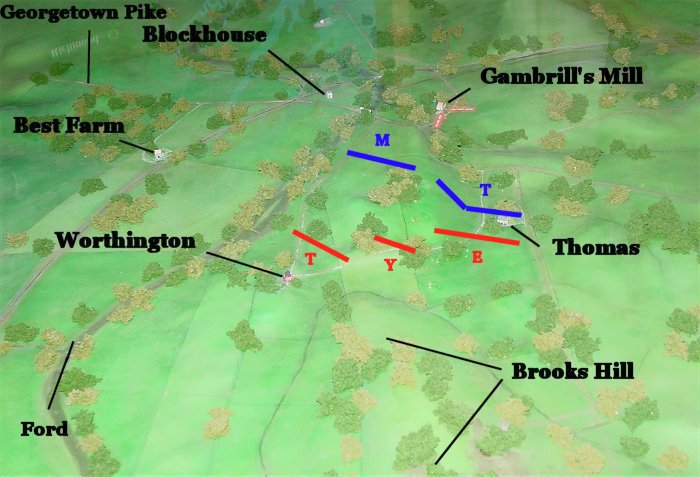
Monocacy
July 9, 1864
As part of Grant's coordinated plan for the Virginia campaign of 1864, a Union force under Franz Sigel was sent south into the Shenandoah Valley. It was repulsed at New Market, and most of the Confederate defenders of the Valley under John C. Breckinridge were shifted east to reinforce Lee's army. Sigel was replaced by David Hunter, who, with little opposition, raided the Valley and advanced on Lynchburg. From the lines of Cold Harbor, Lee sent Breckinridge back toward the Valley along with Jubal Early's Second Corps. Hunter retreated through the harsh terrain of West Virginia, putting his force out of action for weeks.
With the threat to Lynchburg, and therefore to Richmond, passed, and with the Valley clear of Federals, the Confederates were presented with an excellent opportunity. Early's Army of the Valley advanced swiftly down the Shenandoah, then marched east toward Washington D.C. As the major armies settled into siege around Petersburg, Early was Lee's last, best hope. Early's objectives included liberating the prisons at Point Lookout, so he dispatched part of his cavalry force there in what would become a failed operation. In retaliation for Hunter's burnings in the Valley, Early ransomed Union towns during his advance, including Frederick, just to the west of the Monocacy River, where Union forces were gathering.
Lew Wallace, who is better known as the author of Ben Hur, commanded only around 2,300 Union troops near capital - but more men were on the way. Grant had dispatched Rickett's division, then the whole VI Corps. The XIX Corps was also on the way from Louisiana. But by July 9th, only Rickett's division had arrived at the Monocacy, giving Wallace around 5,800 men to delay Early's 15,000 men and to determine whether the Confederate objective was Baltimore or Washington.

National Park Service Electric Map and Battle Summary
This map in the visitors center is shown here with north being roughly toward the top. Off the map to the north, in an area we'll ignore, two smaller forces clashed at another crossing of the river. But here on the area of this map, the main action occurred. The main Confederate effort was originally made along the Georgetown Pike toward Gambrill's Mill, making it obvious that Washington D.C. was the Confederate objective. Early approached from west, or left of the map, along the Georgetown Pike, and Ramseur's division clashed with Union skirmishers along a railroad embankment near the Best Farm.
Confederate cavalry crossed the river at a ford further south and engaged Union troops just beyond the Worthington house, which overlooked the lowland and the ford. After a repulse, the rebel cavalrymen were reinforced and tried again, this time advancing to beyond the Thomas house before being pushed back. Breckinridge with Gordon's infantry division followed, deploying with their left along the river and their right sweeping across Brooks Hill, swinging like a door, to attack Ricketts' division, which had moved into line near the Thomas farm to face the threat. After fierce combat, Ricketts was routed, and Wallace ordered a retreat. The blue lines show the approximate positions of the Union brigades of Truex (T) and McClennan (M), at the height of the battle being attacked by Evans (E), York (Y), and Terry (T).
The Battlefield:
Best Farm - Early probes the Union position
Worthington - Early's Turning Movement
Brooks Hill - Gordon Deploys and Advances
Thomas Farm - Confederate Attack
All content is copyright 2004 by John Hamill. All rights are reserved. No portion may be copied, retransmitted, reposted, duplicated, or used without express written permission.
Back to Civil War Virtual Battlefield Tours